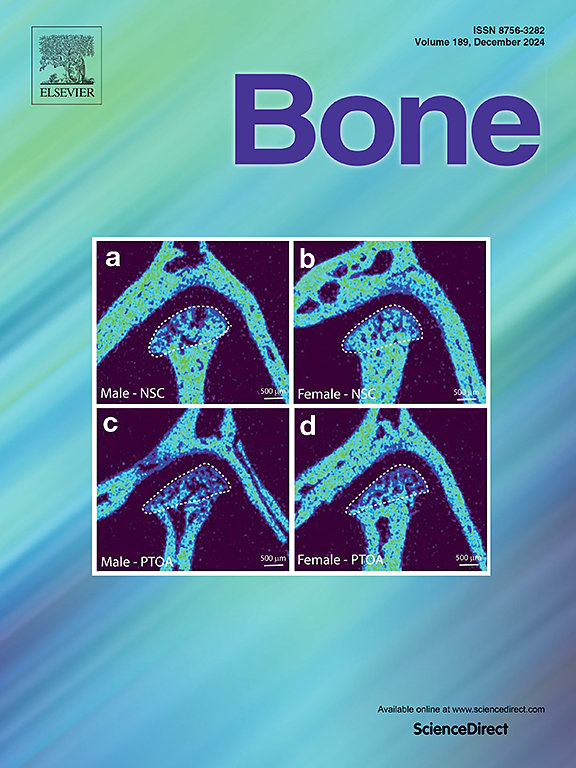Monitoring denosumab therapy using the calcium isotope marker (CIM) technology
IF 3.6
2区 医学
Q2 ENDOCRINOLOGY & METABOLISM
引用次数: 0
Abstract
Denosumab provides a well-established therapy for osteoporosis. Dual-energy X-ray absorptiometry (DXA) and bone turnover markers (BTMs) track changes in bone mineral density (BMD) and turnover. Calcium (Ca) Isotope Markers (CIM), which measure naturally occurring variations in stable Ca isotope ratios in serum (CIM_serum) and urine (CIM_urine), offer a potentially more sensitive and individualized approach for monitoring bone health and therapy responsiveness. In this pilot study, 13 postmenopausal women with DXA-confirmed osteoporosis were initiated on denosumab. Over 24 weeks, serial measurements of CIM_serum, CIM_urine, BMD, BTMs, and parathyroid hormone (PTH) were obtained. CIM thresholds distinguishing net bone Ca uptake from net bone Ca efflux were applied. Baseline CIM values, adjusted for Ca supplement intake (average CIM_serum: −1.09±0.15 ‰ and CIM_urine: 0.00±0.22 ‰), indicated net bone Ca loss. After 60 mg denosumab injection, all patients showed substantial increases in CIM_serum and CIM_urine values by ∼ +0.4 ‰ after one week. Peak values were reached in week 4 (CIM_serum: ∼ −0.8 ‰) to 8 (CIM_serum: ∼ −0.7 ‰). CIM_serum and CIM_urine values correlated positively to PTH. Some patients´ CIM values quickly rose above threshold levels, while others showed more modest or transient changes. Although DXA indicated an increase in the lumbar and hip T-score values after 24 weeks, DXA primarily confirmed group-level gains. BTMs did not reflect individual variations in CIM response. While further validation in larger, controlled cohorts is warranted, these findings highlight CIM's potential to enhance osteoporosis management through personalized treatment monitoring.

使用钙同位素标记(CIM)技术监测地诺单抗治疗。
Denosumab为骨质疏松症提供了一种成熟的治疗方法。双能x线吸收仪(DXA)和骨转换标志物(BTMs)跟踪骨密度(BMD)和骨转换的变化。钙(Ca)同位素标志物(CIM)测量血清(CIM_serum)和尿液(CIM_urine)中自然发生的稳定钙同位素比率的变化,为监测骨骼健康和治疗反应性提供了一种潜在的更敏感和个性化的方法。在这项初步研究中,13名经dxa证实的绝经后骨质疏松症妇女开始使用denosumab。在24 周内,连续测量CIM_serum, CIM_urine, BMD, btm和甲状旁腺激素(PTH)。应用CIM阈值区分净骨钙摄取和净骨钙外排。基线CIM值,根据钙补充摄入量调整(平均cim_血清:-1.09 ± 0.15 ‰和cim_尿液:0.00 ± 0.22 ‰),表明净骨钙流失。所有患者注射60 mg denosumab后,1周后CIM_serum和CIM_urine值显著升高~ + 0.4 ‰。峰值出现在第4周(CIM_serum: ~ - 0.8 ‰)至第8周(CIM_serum: ~ - 0.7 ‰)。CIM_serum和CIM_urine与PTH呈正相关。一些患者的CIM值迅速上升到阈值以上,而另一些患者则表现出更温和或短暂的变化。虽然DXA显示24 周后腰椎和髋关节t评分值增加,但DXA主要证实了组水平的增加。btm不能反映CIM反应的个体差异。虽然需要在更大的对照队列中进一步验证,但这些发现强调了CIM通过个性化治疗监测加强骨质疏松症管理的潜力。
本文章由计算机程序翻译,如有差异,请以英文原文为准。
求助全文
约1分钟内获得全文
求助全文
来源期刊

Bone
医学-内分泌学与代谢
CiteScore
8.90
自引率
4.90%
发文量
264
审稿时长
30 days
期刊介绍:
BONE is an interdisciplinary forum for the rapid publication of original articles and reviews on basic, translational, and clinical aspects of bone and mineral metabolism. The Journal also encourages submissions related to interactions of bone with other organ systems, including cartilage, endocrine, muscle, fat, neural, vascular, gastrointestinal, hematopoietic, and immune systems. Particular attention is placed on the application of experimental studies to clinical practice.
 求助内容:
求助内容: 应助结果提醒方式:
应助结果提醒方式:


